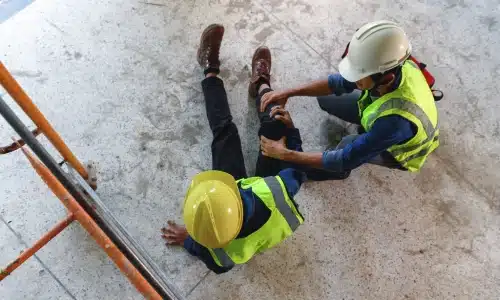 Construction sites, especially in a busy urban area like Atlanta inherently risky, with countless potential dangers lurking at every turn. The fast-paced nature of Atlanta construction projects and the complexity of working in a densely populated environment often amplify these hazards.
Construction sites, especially in a busy urban area like Atlanta inherently risky, with countless potential dangers lurking at every turn. The fast-paced nature of Atlanta construction projects and the complexity of working in a densely populated environment often amplify these hazards.
If you or a loved one experiences an accident on such a site, being informed about the necessary steps to take is crucial. Understanding what actions to follow after a construction site injury can significantly influence your chances of securing rightful compensation or pursuing any legal claims that may arise.
How Do Safety Regulations Impact Construction Accident Lawsuits?
Safety regulations, such as those enforced by OSHA (Occupational Safety and Health Administration), have a significant impact on workplace injury claims by:
- Setting clear guidelines for maintaining a safe work environment
- Identifying responsible parties when accidents occur
- Enforcing the use of necessary protective gear and safety measures
- Requiring regular safety training and hazard assessments
- Mandating the installation of protective barriers, guardrails, and other safety features
When these regulations are ignored or breached, they can serve as strong evidence to support an injury claim, often indicating negligence on the part of the employer or contractor.
Why You Need Our Construction Accident Lawyers
Dealing with the aftermath of a construction site injury can be enormous, especially when guiding the legal maze. Taking the help of our expert construction accident lawyer is essential to protect your rights and ensure you receive the compensation you’re entitled to.
Our experienced construction accident lawyers will:
- Conduct a Comprehensive Investigation: They will meticulously examine the details of the incident, gather crucial evidence, and identify every party that may be liable for your injury.
- Identify Your Legal Options: Whether pursuing a workers’ comp claim, initiating a personal injury lawsuit, or combining both, they’ll guide you toward the most effective legal path.
- Negotiate With Insurance Companies: Our skilled lawyer will handle all negotiations with insurance providers to secure the highest possible settlement on your behalf.
- Represent You in Court: If your case escalates to trial, our lawyer will advocate for you, presenting a compelling case to ensure you achieve a fair outcome.
- Manage Legal Deadlines and Paperwork: They will handle all the paperwork and ensure your claim adheres to legal deadlines and regulations, preventing unnecessary setbacks.
When choosing our construction accident lawyer, prioritize one with a history of successful outcomes in similar cases, excellent communication skills, and a genuine dedication to fighting for your rights.
Leading Causes of Construction Site Accidents
Construction sites can be hazardous, with accidents occurring due to various factors. Some of the most frequent causes of injuries on construction sites include:
- Falls from heights, such as ladders, scaffolding, or uneven surfaces
- Being hit by falling objects, like tools, building materials, or debris
- Trapped or crushed incidents, often involving workers getting caught between machinery or inside trenches
- Electrical hazards, including contact with live wires or faulty equipment
- Crane malfunctions leading to unexpected movements or collapses
- Vehicle collisions involving trucks, forklifts, or other heavy machinery
- Heavy machinery mishaps, including rollovers or equipment malfunction
- Welding burns or eye injuries due to inadequate protection
- Unsafe handling of power tools, resulting in cuts, punctures, or burns
- Exposure to harmful substances, such as asbestos or lead-based paints
- Fire hazards and explosions, often from gas leaks or flammable materials
- Repetitive strain injuries from performing the same task repeatedly
- Soil or ground collapses, especially during excavation work
These incidents can lead to severe injuries, disabilities, or even fatalities, underscoring the importance of strict safety protocols on construction sites.
Most Common Construction Site Injuries
- Height-Related Falls: One of the most frequent accidents on construction sites involves workers falling from elevated areas such as scaffolding, ladders, or rooftops. These incidents can lead to severe injuries, including fractures, spinal damage, and traumatic brain injuries (TBIs).
- Accidents Involving Heavy Machinery: Working with large equipment like forklifts, cranes, and power tools presents significant risks. Accidents involving such machinery can cause anything from deep cuts and amputations to severe crush injuries, often requiring extensive medical intervention and rehabilitation.
- Electrical Hazards: Electrical accidents are common on construction sites, resulting in minor electric shocks, severe burns, or life-threatening injuries. These hazards are particularly dangerous when working near exposed wires, live circuits, or faulty equipment.
- Impact from Falling Objects: Construction workers face constant danger from falling debris, tools, or building materials. Such incidents can lead to head trauma, concussions, or more serious injuries like TBIs, especially if proper protective gear isn’t worn.
- Strain and Repetitive Motion Injuries: The physically demanding nature of construction work often leads to overexertion or repetitive strain injuries. These injuries build up over time, potentially causing chronic pain, muscle strain, or joint issues that can require ongoing medical treatment.
- Hazardous Substance Exposure: Workers on construction sites are sometimes exposed to dangerous substances like asbestos, toxic chemicals, or dust particles. Prolonged exposure can result in respiratory issues, skin conditions, or, in severe cases, the development of life-threatening illnesses such as cancer.
Steps to Take If You Are Injured in Construction Site
If you are hurt while working on a construction site, your main source of financial support is usually workers’ compensation. Regardless of who was at blame for the incident, this no-fault insurance scheme is intended to support workers who sustain illnesses or injuries linked to their jobs by providing compensation for medical bills, missed income, and rehabilitation expenditures.
The workers’ compensation system aims to provide quick access to financial assistance, ensuring injured workers can receive treatment and maintain some income during recovery. However, in most situations, workers’ compensation is the sole remedy available to construction workers, preventing them from suing their employer directly for additional damages.
To successfully navigate the workers’ compensation process, you should:
- Report the Incident Immediately: Inform your employer about the accident as soon as possible, as each state has specific deadlines for reporting injuries.
- Get Medical Attention: Seek treatment from an approved healthcare provider and strictly follow their recommendations and treatment plan.
- Keep Detailed Records: Document your injuries, medical treatments, lost wages, and any other expenses totally related to your accident.
- File Your Claim Promptly: Submit the necessary paperwork through your employer or consult a workers’ compensation attorney to guide you through the claim process.
While workers’ compensation offers essential benefits, it might not cover all your losses or fully compensate for your suffering. In some instances, you might be eligible to pursue a separate personal injury claim against a third party, such as equipment manufacturers or subcontractors, for additional compensation.
Essential OSHA Violations for Construction Site Safety
Construction sites come with numerous risks, which is why OSHA enforces stringent safety regulations to protect workers. Here are some of the key OSHA standards that every construction site must adhere to:
- Fall Protection (29 CFR 1926.501): Employers are required to implement protective measures such as guardrails, safety harnesses, or nets for workers exposed to potential falls from heights.
- Scaffolding Safety (29 CFR 1926.451): This regulation mandates that scaffolds be properly designed, constructed, and inspected to ensure stability and safe use.
- Hazard Communication (29 CFR 1926.59): Employers must clearly communicate the dangers of hazardous substances on-site, using warning labels, safety data sheets, and training programs.
- Personal Protective Equipment (PPE) (29 CFR 1926.28): Employers must provide necessary PPE, including helmets, protective eyewear, gloves, and footwear to safeguard workers against job-related hazards.
- Trenching and Excavation Safety (29 CFR 1926.650-652): These guidelines ensure excavation work is done safely, requiring protective measures to prevent trench collapses.
- Electrical Safety Standards (29 CFR 1926.400-449): Outlines the safe handling of electrical systems, equipment, and installations to minimize the risk of electrocution.
- Proper Use of Tools and Equipment (29 CFR 1926.300): Employers must ensure that all machinery and tools are maintained, inspected, and used following safety guidelines to avoid accidents.
- Hearing Protection (29 CFR 1926.52): OSHA enforces regulations on noise exposure, requiring employers to provide hearing protection and monitor noise levels.
- Cranes and Hoisting Equipment (29 CFR 1926.1400-1442): Sets forth requirements for the safe operation, certification, and inspection of cranes, ensuring they are used properly and safely.
These OSHA regulations are designed to minimize construction site risks, helping create a safer work environment for all employees. Compliance with these standards is crucial in preventing accidents and ensuring workers’ safety.
Compensations For Construction Site Accident
While workers’ compensation is often the primary source of relief for injured construction workers, there are instances where pursuing a personal injury claim might be more appropriate.
This option is viable if the accident was caused by a party other than your direct employer, such as an equipment manufacturer, another contractor, or a property owner.
Personal injury claims offer the opportunity to recover a broader range of damages, which can include:
- Medical Bills: Covering all healthcare costs, including current treatments, ongoing care, and any future medical needs.
- Lost Income: Compensation for wages lost during recovery, as well as any diminished earning capacity in the future.
- Pain and Suffering: Financial compensation for the physical and emotional distress resulting from the accident.
- Punitive Damages: In rare cases, additional damages may be awarded to penalize the at-fault party for particularly reckless or intentional conduct.
To be successful in a personal injury claim, you must provide clear evidence that a third party’s negligence directly caused your injuries. This may involve collecting accident reports, eyewitness accounts, expert analysis, and photographic evidence of the site.
Getting the support of a skilled construction accident lawyer can be essential to navigating the complexities of your case, helping you build a strong claim, and maximizing the compensation you deserve.
Reach Out to Our Construction Accident Attorneys Today!
Awareness of potential risks and understanding your rights as a construction worker are essential for your safety and well-being. Taking quick action after an accident and adhering to safety guidelines can greatly influence your recovery and potential compensation.
If you’ve been injured and need legal guidance, our experienced team at the CEO Lawyer Personal Injury Law Firm is here to help. We offer dedicated support and personalized consultations to evaluate your situation and protect your rights.
Contact our Atlanta-based construction accident attorneys today for a free case evaluation and to explore the best legal options for securing the compensation you deserve.
Schedule your free consultation today at (888) 307-3792, and let us fight for the compensation you deserve.



